Compulab Rolls-Out Passively-Cooled Airtop Systems
by Anton Shilov on January 14, 2016 5:05 AM EST
Compulab, a maker of miniature and small form-factor computers, is introducing its first desktop system called Airtop today. The new computer can be equipped with rather high-performance components, but is completely fanless and only uses the company’s proprietary natural air-flow (NAF) cooling technology.
Compulab’s Airtop is a compact 7.5-liter desktop system that can dissipate up to 200W of heat using only passive cooling methods. The Airtop utilizes various industry-standard components and can be configured as a gaming PC, a server or a workstation. The system is based on a proprietary motherboard featuring Intel’s C226 platform controller hub (PCH) designed specifically for the Airtop with NAF cooling. The mainboard places CPU socket, DIMM slots, PCI Express x16 slot and other components in a way to enable the most efficient dissipation of heat. To eliminate hot components from the case, the Airtop uses an external PSU with a mini-DIN connector.
The proprietary Airtop mainboard is compatible with Intel Core i7 and Intel Xeon E3 v4 microprocessors based on Intel’s Haswell or Broadwell micro-architectures (LGA1150 packaging) as well as various graphics cards, including NVIDIA’s GeForce GTX 950 and Quadro M4000.
The Airtop can be equipped with up to 32 GB of DDR3-1866 memory, four 2.5-inch Serial ATA HDDs/SSDs, one M.2 solid-state drive and one mSATA solid-state drive. The system features two Gigabit Ethernet network controllers (four more may be added using an extension card), a 802.11ac Wi-Fi card with two SIM card sockets, four SMA antennas, four USB 3.0 ports on rear panel, six USB 2.0 ports in total, three RS232 ports, multi-channel audio and so on. While the system utilizes its own mainboard, all the other components are industry-standard and can be upgraded when and if needed.
The NAF heat-exchange system uses two special side-panels, each of which can dissipate up to 100W of heat. The side-panels are equipped with traditional flat copper heat-pipe arrays (with micro-channels) that take away heat from the hottest components (i.e., the CPU and the GPU) and spread it across the side-panel. The heat from the heat-pipe arrays is removed by the special air-tube panels consisting of 14 tubes with air inside. Once the air gets hot, it starts to rise up, removing heat from the side panels (see Compulab's video for details). Everything happens naturally (via convection) and completely silently. The air tubes are open on both ends and efficiency of convection depends on the movement of air through them. For efficient cooling, owners of Compulab’s Airtop will have to ensure that the tubes are not clogged with dust, which is common in industrial and other environments.
While Compulab’s Airtop is in many ways unique, it reminds us of Zalman’s TNN 500 and TNN 300 fanless cases released about a decade ago. Those cases were considerably bigger and acted like giant heatsinks with a lot of heat-pipes inside, but they combined the same cooling techniques as the Airtop.
Compulab claims that it took years to develop the NAF heat-exchange technology and three years to design the Airtop system. Right now, the desktop is only compatible with previous-generation Intel microprocessors and does not support modern technologies like NVMe or USB 3.1, but eventually the company could develop a more advanced motherboard for the latest-generation Skylake and the upcoming Kaby Lake chips in LGA1151 packaging.
The Airtop is relatively small, its dimensions are 10 cm (w) x 30 cm (h) x 25.5 cm (d) – 4” (w) x 12” (h) x 10” (d). The weight of the PC depends on configuration and can be between 4 and 7 kilograms.
The Compulab Airtop is available as a pre-configured system or as a barebone SFF PC for DIY enthusiasts. Since the system is unique and uses numerous components designed specifically for the Airtop, it naturally is not affordable. The Airtop barebone costs $1128, the Airtop-S passively-cooled server (featuring the Intel Xeon E3-1285L v4 CPU) starts at $1810, the Airtop-G gaming PC (with the Intel Core i7-5775C and the NVIDIA GeForce GTX 950 graphics card) is priced at $1968, whereas the Airtop-W workstation (with Intel’s Xeon E3-1285L v4 chip and NVIDIA’s Quadro M4000 graphics adapter) costs $2999. The systems will be available in Q1 2016.
Source: Airtop PC


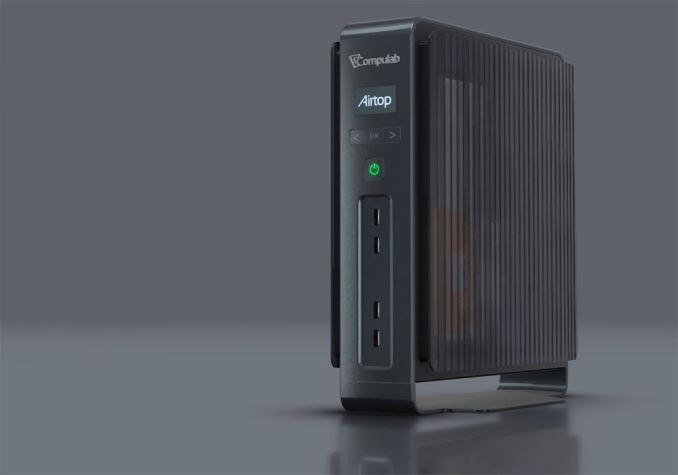
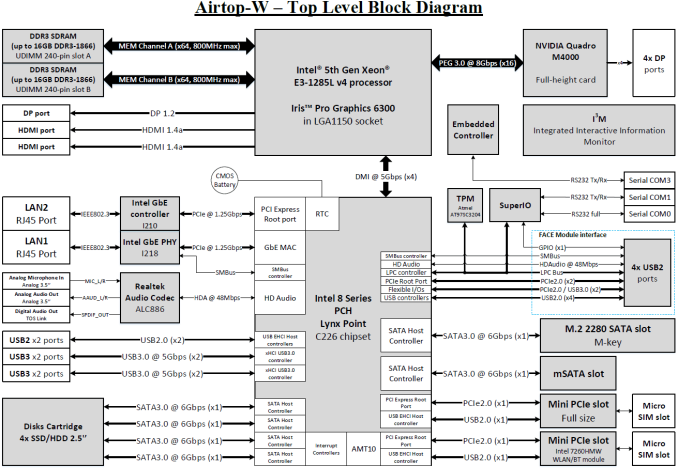
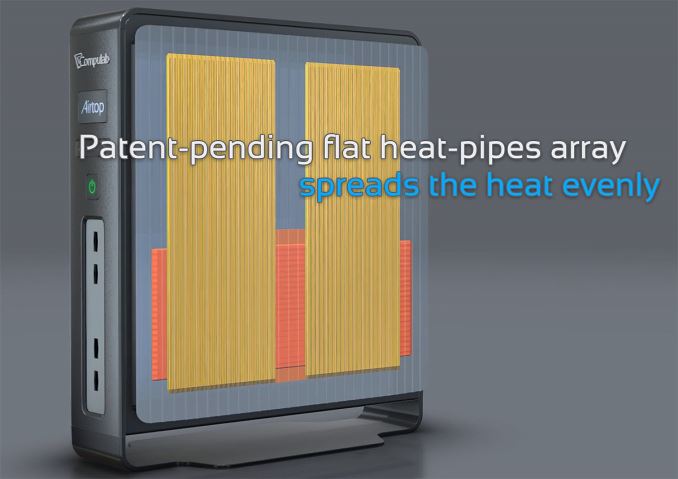
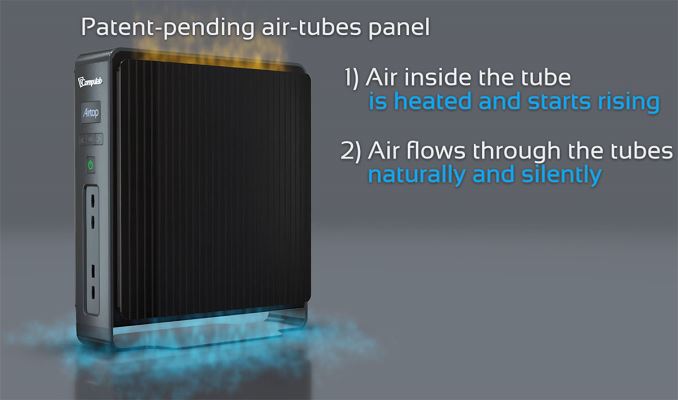
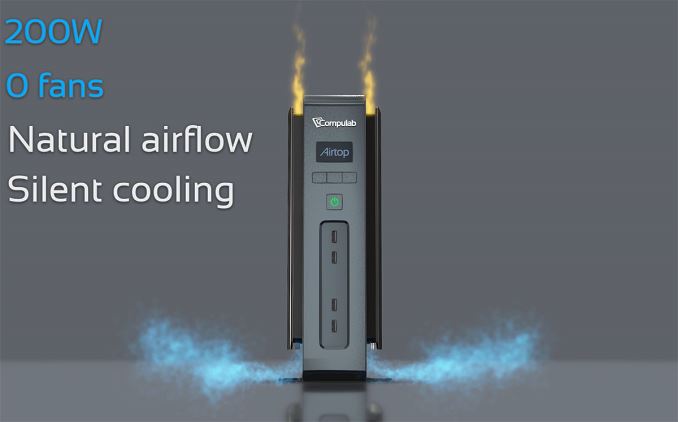








35 Comments
View All Comments
ddriver - Thursday, January 14, 2016 - link
Orientation is key, convection will work either way, but how efficiently it will displace heat depends on the orientation of the radiator and the fins. When people hear finned radiator, they imagine the typical tower radiator used on CPUs or chipsets, whose design and orientation make up for extremely poor ability to displace heat without a fan. I am sure that is also he case of your previous products performing poorly.I am willing to bet there is absolutely nothing special about your chimneys - because I have over a decade experience in design, engineering and simulations - there is nothing you can possibly do to improve that. You might have made it more "touchable" only by thermal insulation on the outside, this would drop the skin temperature, but would hamper the cooling capacity as do the enclosed tubes - there is a trade-off here - reduce cooling capacity for the sake of reducing the skin temperature. There is nothing new or even remotely innovative about this, if that took your engineers 3 years to figure out you should honestly consider getting someone better. I could have told you that in 2 minutes and rigged up a simulation in another 10. 3 years... just wow :)
As I said, I would not be surprise if you patent that, but that would not prove your "invention" - it will only prove what a complete joke the patent system is ;)
ddriver - Thursday, January 14, 2016 - link
Furthermore, in this form factor an actually cleverly designed cooling solution could easily manage to displace 400++ watts. And even though it will require a little more complex manufacturing than what you are used to, it can still be done at a small fraction of the price you ask for your existing products.royalcrown - Thursday, January 14, 2016 - link
If you have a decade of design experience then you should refer to it as surface temperature, which is affected by delta T.ddriver - Thursday, January 14, 2016 - link
I am not a native English speaker, so your argument is that of a straw man. The fact I reverse engineered that "3 year worth of genius invention" in my mind in an instant is testament to my experience. That being said, I am fairly certain I have encountered "skin" in engineering books as referring to the outer covering of a parts assembly, which is what dictated my choice, as that is more specific than "surface" which is ambiguous due to the large number of surfaces it may refer to in the particular case.GY - Thursday, January 14, 2016 - link
"I have over a decade experience in design, engineering and simulations - there is nothing you can possibly do to improve that"So, you spent 10 years and could not find improvement, and it means that none else can.
Healthy reasoning.
ddriver - Thursday, January 14, 2016 - link
If you were into engineering, you'd know what I am talking about. There is a bell shaped curve for everything, and it has only one peak. The same way nobody in a several thousand years managed to find a better shape for the wheel than the circle - is it as good as it gets.Their "revolutionary invention" is heat insulation to mask how hot the radiators really are and using a better orientation to move more air compared to their previous products which barely moved any. That's all there is to it.
I just hope no user ever decides to put that thing horizontally, because it will cook in an instant.
GY - Thursday, January 14, 2016 - link
Well, I'm deeply into engineering and physics of thermal design ...ddriver - Thursday, January 14, 2016 - link
If that's indeed the case why is that you refer to such a trivial concept as a "real breakthrough"?Here is the chain of reasoning that needs to be traversed in order to solve this engineering problem:
problem - we need to cool stuff down
solution - we use a heat sink
problem - heat sink can't displace the heat fast enough
solution - put the heat sink radiator in a way to create more air flow
problem - radiator is too hot to the touch
solution - cover radiator with heat insulator leaving enough room for air to circulate
Just a few painfully obvious steps which should not be a problem even for a self taught enthusiast, much less for an experienced engineer.
Granted, it may well be the first time it is applied in a commercial PC, but that most certainly doesn't make it new.
Compulab - Thursday, January 14, 2016 - link
The list of problem-solution you describe above is a healthy engineer process, not unsimilar to our development process.There are many correct observations, some are missing. There is one glaring (and common) misunderstanding about insulation.
We worked hard to conceptualize and develop Airtop. There are many companies in the industry that copy technology. We applied for patents to protect our investment.
You are entitled to believe you could develop it sooner. Maybe so. Many developments are obvious in hindsight. That doesn't make them stupid.
Sincerely,
Irad Stavi
Compulab
ddriver - Sunday, January 17, 2016 - link
I never said your product is stupid, what is stupid are your claims on "inventing" stuff. You need to dial it down, because it is ridiculous. Also consider hiring a better designer and a little less absurd product pricing.